How Business Operates
VerifiedAdded on 2023/06/04
|9
|2668
|326
AI Summary
This report discusses the roles and responsibilities of a marketing team, team development stages, motivation theories, leadership styles, customer service impact, and customer profiling in business. It also highlights the importance of effective customer service and its benefits to a business.
Contribute Materials
Your contribution can guide someone’s learning journey. Share your
documents today.
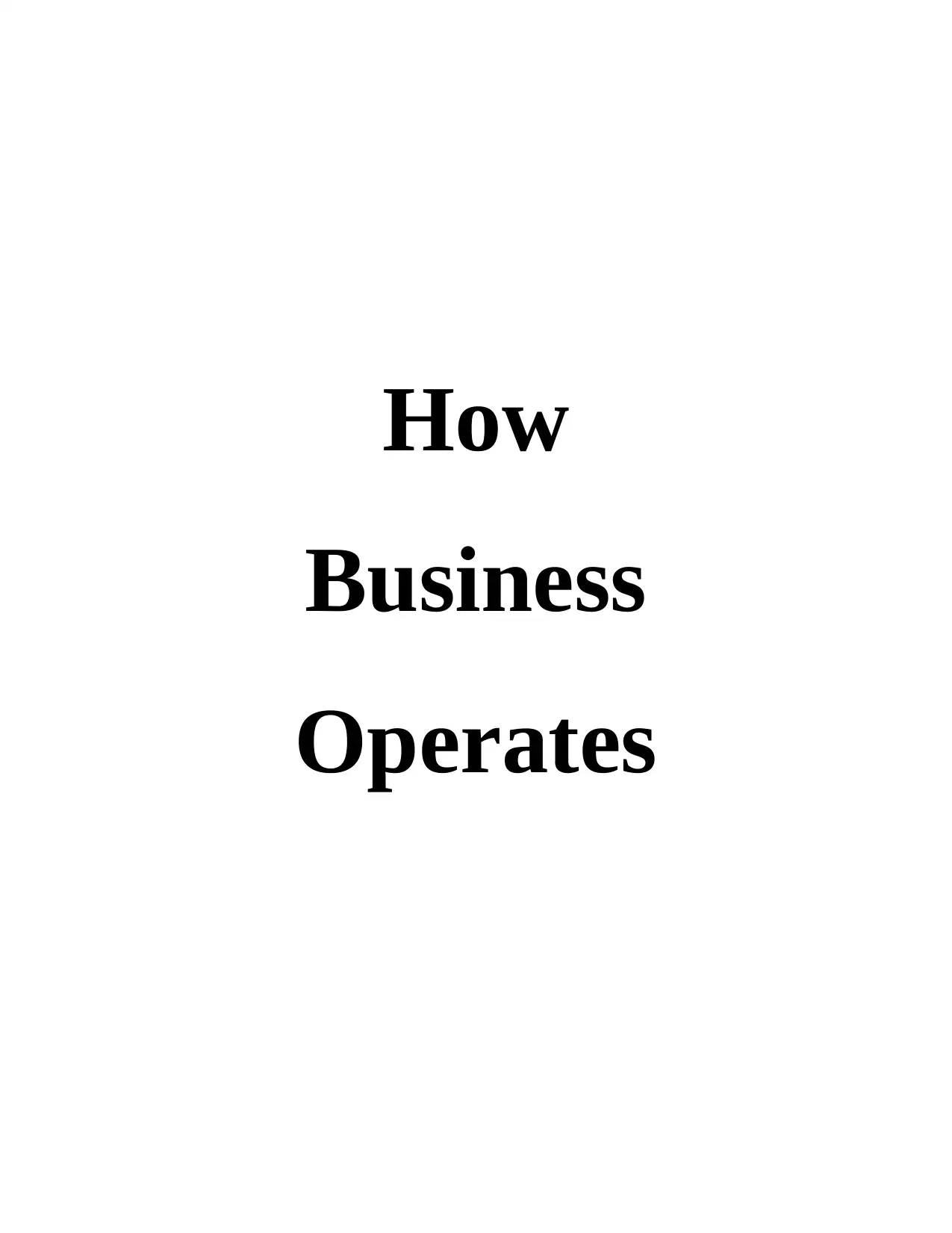
How
Business
Operates
Business
Operates
Secure Best Marks with AI Grader
Need help grading? Try our AI Grader for instant feedback on your assignments.
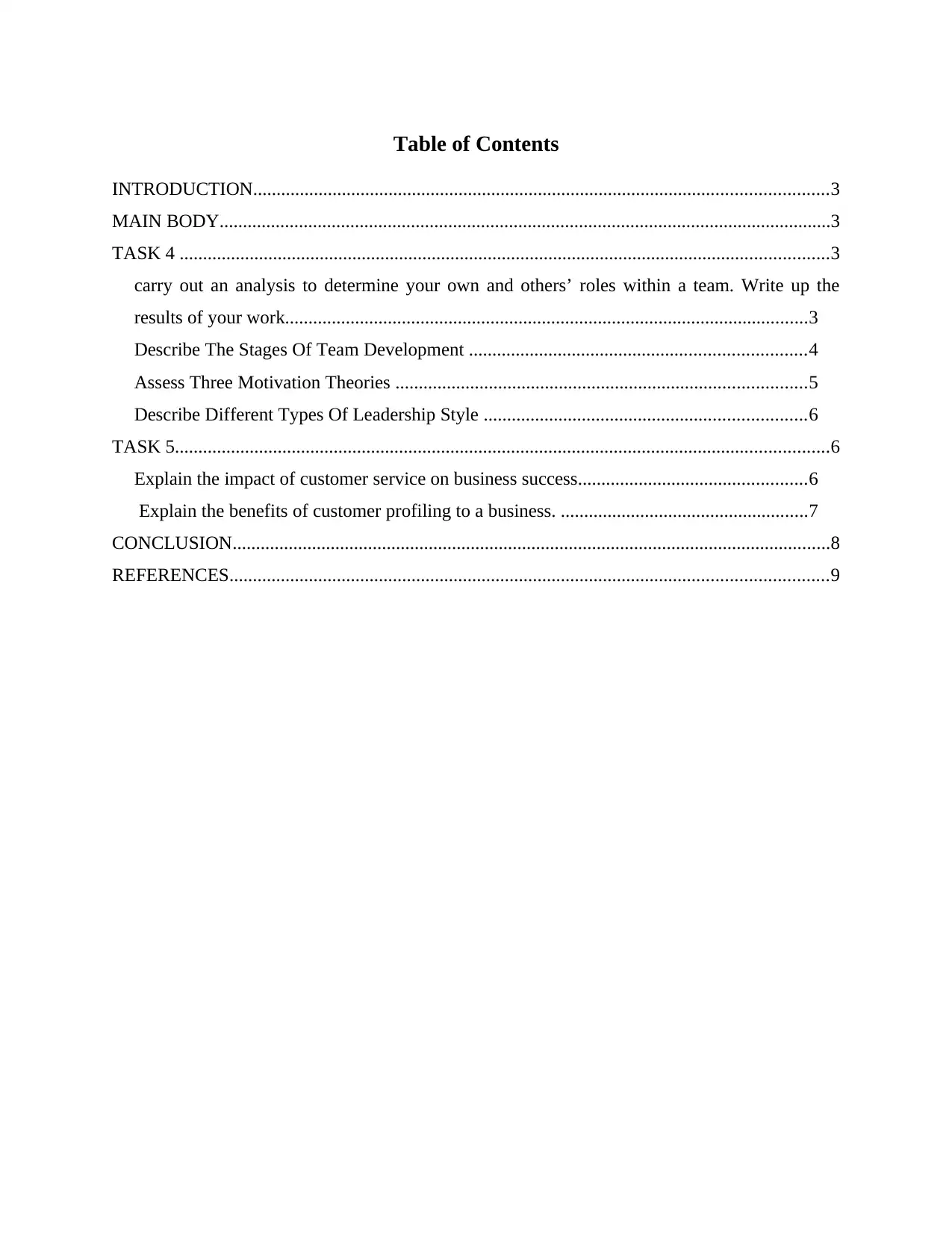
Table of Contents
INTRODUCTION...........................................................................................................................3
MAIN BODY...................................................................................................................................3
TASK 4 ...........................................................................................................................................3
carry out an analysis to determine your own and others’ roles within a team. Write up the
results of your work................................................................................................................3
Describe The Stages Of Team Development ........................................................................4
Assess Three Motivation Theories ........................................................................................5
Describe Different Types Of Leadership Style .....................................................................6
TASK 5............................................................................................................................................6
Explain the impact of customer service on business success.................................................6
Explain the benefits of customer profiling to a business. .....................................................7
CONCLUSION................................................................................................................................8
REFERENCES................................................................................................................................9
INTRODUCTION...........................................................................................................................3
MAIN BODY...................................................................................................................................3
TASK 4 ...........................................................................................................................................3
carry out an analysis to determine your own and others’ roles within a team. Write up the
results of your work................................................................................................................3
Describe The Stages Of Team Development ........................................................................4
Assess Three Motivation Theories ........................................................................................5
Describe Different Types Of Leadership Style .....................................................................6
TASK 5............................................................................................................................................6
Explain the impact of customer service on business success.................................................6
Explain the benefits of customer profiling to a business. .....................................................7
CONCLUSION................................................................................................................................8
REFERENCES................................................................................................................................9
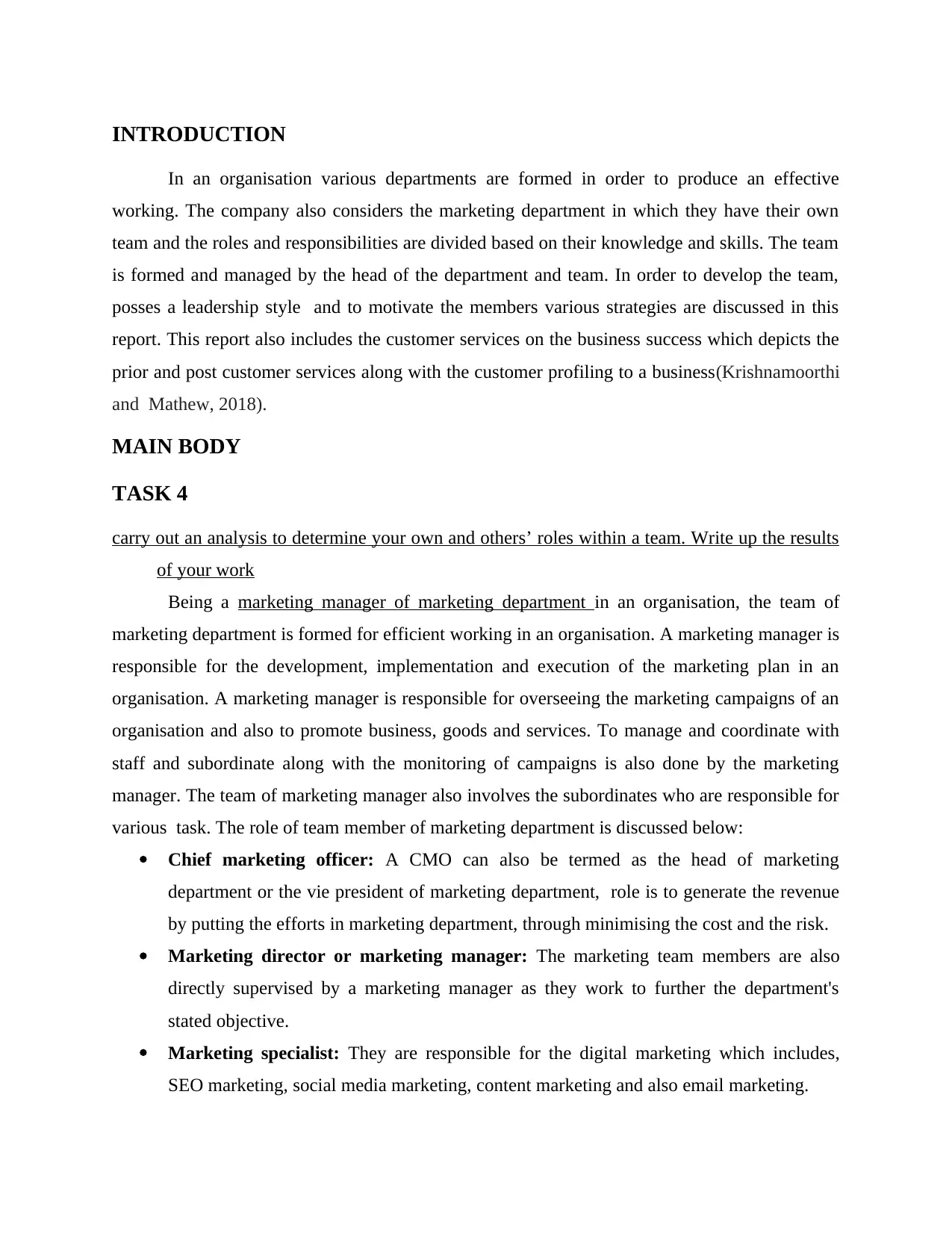
INTRODUCTION
In an organisation various departments are formed in order to produce an effective
working. The company also considers the marketing department in which they have their own
team and the roles and responsibilities are divided based on their knowledge and skills. The team
is formed and managed by the head of the department and team. In order to develop the team,
posses a leadership style and to motivate the members various strategies are discussed in this
report. This report also includes the customer services on the business success which depicts the
prior and post customer services along with the customer profiling to a business(Krishnamoorthi
and Mathew, 2018).
MAIN BODY
TASK 4
carry out an analysis to determine your own and others’ roles within a team. Write up the results
of your work
Being a marketing manager of marketing department in an organisation, the team of
marketing department is formed for efficient working in an organisation. A marketing manager is
responsible for the development, implementation and execution of the marketing plan in an
organisation. A marketing manager is responsible for overseeing the marketing campaigns of an
organisation and also to promote business, goods and services. To manage and coordinate with
staff and subordinate along with the monitoring of campaigns is also done by the marketing
manager. The team of marketing manager also involves the subordinates who are responsible for
various task. The role of team member of marketing department is discussed below:
Chief marketing officer: A CMO can also be termed as the head of marketing
department or the vie president of marketing department, role is to generate the revenue
by putting the efforts in marketing department, through minimising the cost and the risk.
Marketing director or marketing manager: The marketing team members are also
directly supervised by a marketing manager as they work to further the department's
stated objective.
Marketing specialist: They are responsible for the digital marketing which includes,
SEO marketing, social media marketing, content marketing and also email marketing.
In an organisation various departments are formed in order to produce an effective
working. The company also considers the marketing department in which they have their own
team and the roles and responsibilities are divided based on their knowledge and skills. The team
is formed and managed by the head of the department and team. In order to develop the team,
posses a leadership style and to motivate the members various strategies are discussed in this
report. This report also includes the customer services on the business success which depicts the
prior and post customer services along with the customer profiling to a business(Krishnamoorthi
and Mathew, 2018).
MAIN BODY
TASK 4
carry out an analysis to determine your own and others’ roles within a team. Write up the results
of your work
Being a marketing manager of marketing department in an organisation, the team of
marketing department is formed for efficient working in an organisation. A marketing manager is
responsible for the development, implementation and execution of the marketing plan in an
organisation. A marketing manager is responsible for overseeing the marketing campaigns of an
organisation and also to promote business, goods and services. To manage and coordinate with
staff and subordinate along with the monitoring of campaigns is also done by the marketing
manager. The team of marketing manager also involves the subordinates who are responsible for
various task. The role of team member of marketing department is discussed below:
Chief marketing officer: A CMO can also be termed as the head of marketing
department or the vie president of marketing department, role is to generate the revenue
by putting the efforts in marketing department, through minimising the cost and the risk.
Marketing director or marketing manager: The marketing team members are also
directly supervised by a marketing manager as they work to further the department's
stated objective.
Marketing specialist: They are responsible for the digital marketing which includes,
SEO marketing, social media marketing, content marketing and also email marketing.
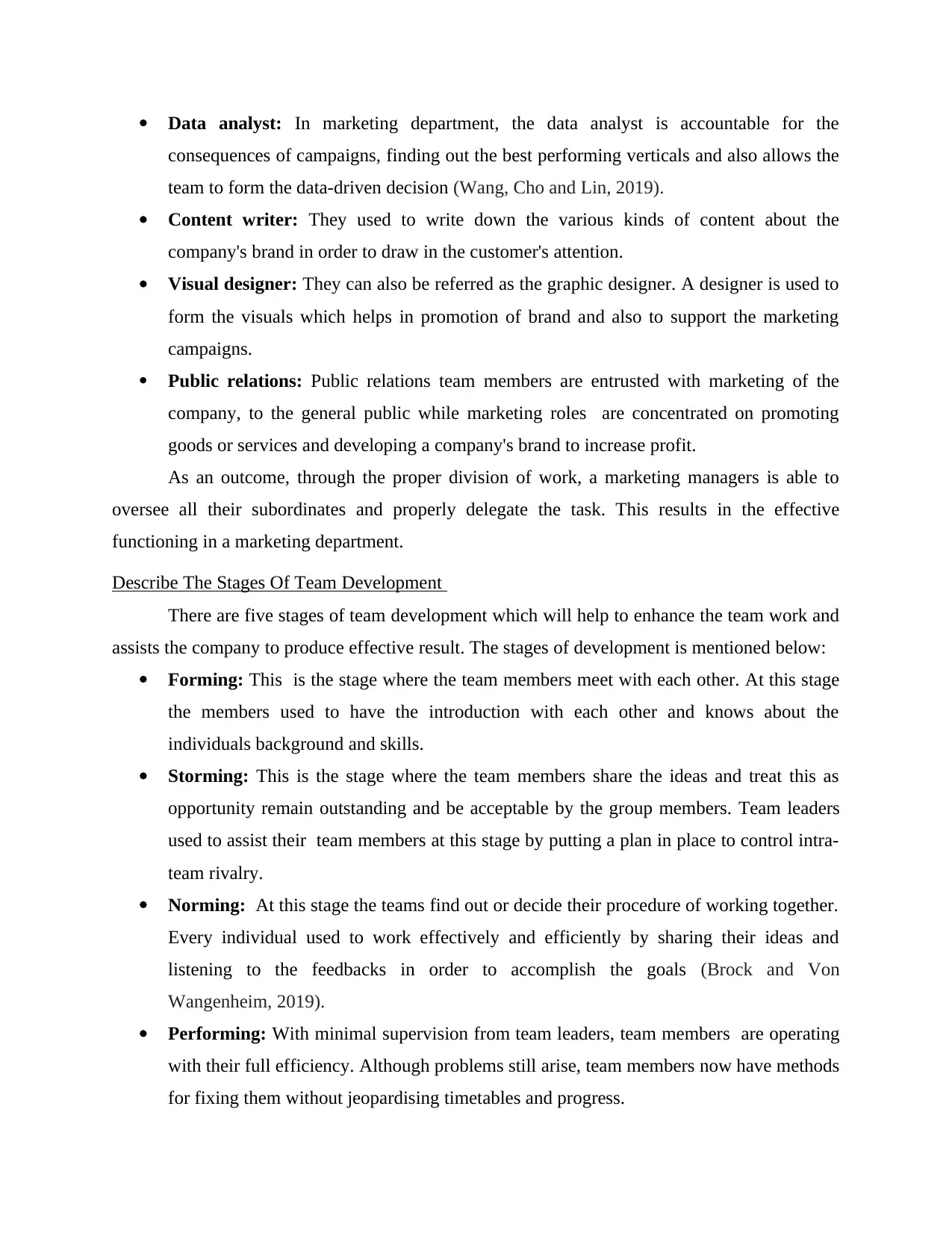
Data analyst: In marketing department, the data analyst is accountable for the
consequences of campaigns, finding out the best performing verticals and also allows the
team to form the data-driven decision (Wang, Cho and Lin, 2019).
Content writer: They used to write down the various kinds of content about the
company's brand in order to draw in the customer's attention.
Visual designer: They can also be referred as the graphic designer. A designer is used to
form the visuals which helps in promotion of brand and also to support the marketing
campaigns.
Public relations: Public relations team members are entrusted with marketing of the
company, to the general public while marketing roles are concentrated on promoting
goods or services and developing a company's brand to increase profit.
As an outcome, through the proper division of work, a marketing managers is able to
oversee all their subordinates and properly delegate the task. This results in the effective
functioning in a marketing department.
Describe The Stages Of Team Development
There are five stages of team development which will help to enhance the team work and
assists the company to produce effective result. The stages of development is mentioned below:
Forming: This is the stage where the team members meet with each other. At this stage
the members used to have the introduction with each other and knows about the
individuals background and skills.
Storming: This is the stage where the team members share the ideas and treat this as
opportunity remain outstanding and be acceptable by the group members. Team leaders
used to assist their team members at this stage by putting a plan in place to control intra-
team rivalry.
Norming: At this stage the teams find out or decide their procedure of working together.
Every individual used to work effectively and efficiently by sharing their ideas and
listening to the feedbacks in order to accomplish the goals (Brock and Von
Wangenheim, 2019).
Performing: With minimal supervision from team leaders, team members are operating
with their full efficiency. Although problems still arise, team members now have methods
for fixing them without jeopardising timetables and progress.
consequences of campaigns, finding out the best performing verticals and also allows the
team to form the data-driven decision (Wang, Cho and Lin, 2019).
Content writer: They used to write down the various kinds of content about the
company's brand in order to draw in the customer's attention.
Visual designer: They can also be referred as the graphic designer. A designer is used to
form the visuals which helps in promotion of brand and also to support the marketing
campaigns.
Public relations: Public relations team members are entrusted with marketing of the
company, to the general public while marketing roles are concentrated on promoting
goods or services and developing a company's brand to increase profit.
As an outcome, through the proper division of work, a marketing managers is able to
oversee all their subordinates and properly delegate the task. This results in the effective
functioning in a marketing department.
Describe The Stages Of Team Development
There are five stages of team development which will help to enhance the team work and
assists the company to produce effective result. The stages of development is mentioned below:
Forming: This is the stage where the team members meet with each other. At this stage
the members used to have the introduction with each other and knows about the
individuals background and skills.
Storming: This is the stage where the team members share the ideas and treat this as
opportunity remain outstanding and be acceptable by the group members. Team leaders
used to assist their team members at this stage by putting a plan in place to control intra-
team rivalry.
Norming: At this stage the teams find out or decide their procedure of working together.
Every individual used to work effectively and efficiently by sharing their ideas and
listening to the feedbacks in order to accomplish the goals (Brock and Von
Wangenheim, 2019).
Performing: With minimal supervision from team leaders, team members are operating
with their full efficiency. Although problems still arise, team members now have methods
for fixing them without jeopardising timetables and progress.
Secure Best Marks with AI Grader
Need help grading? Try our AI Grader for instant feedback on your assignments.
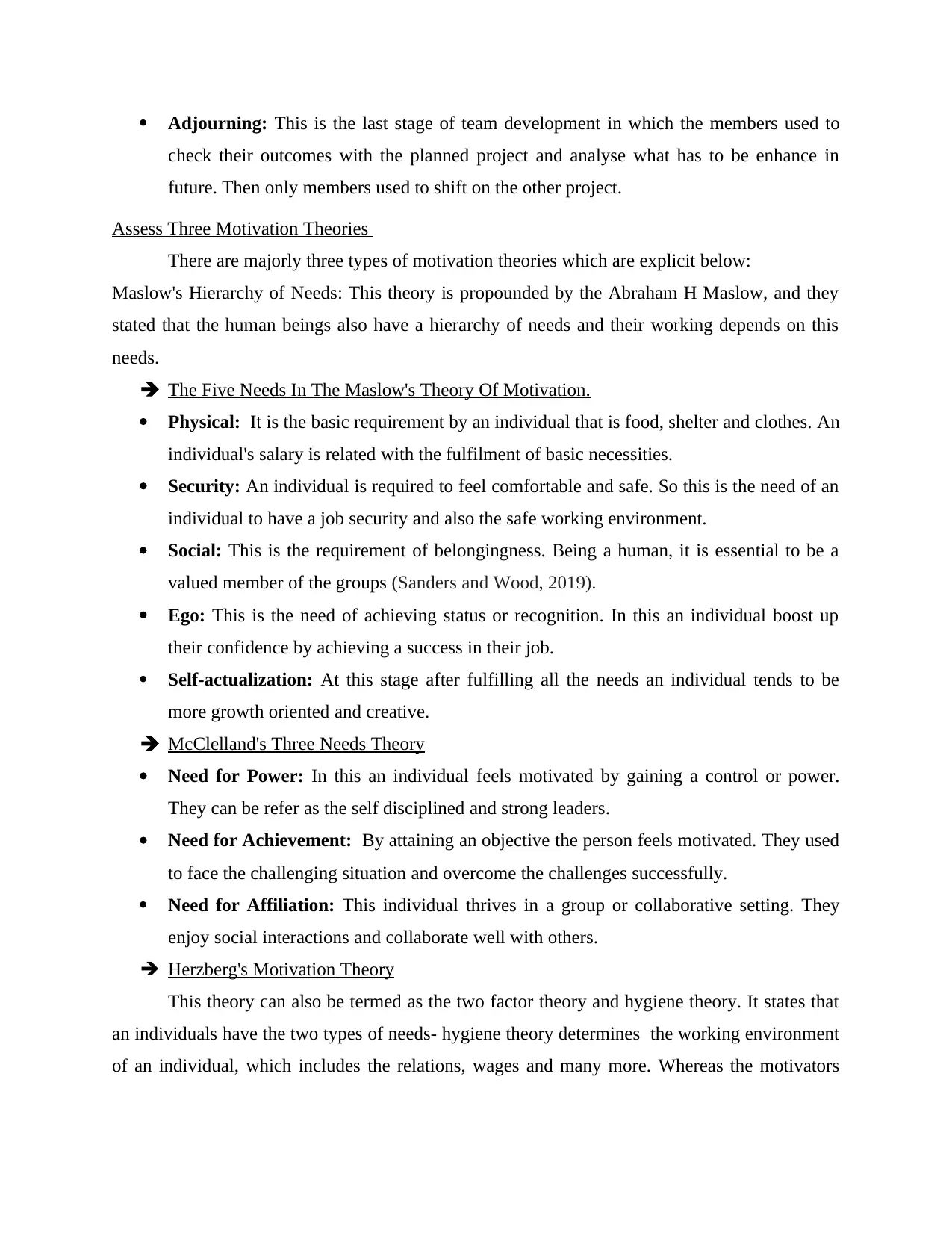
Adjourning: This is the last stage of team development in which the members used to
check their outcomes with the planned project and analyse what has to be enhance in
future. Then only members used to shift on the other project.
Assess Three Motivation Theories
There are majorly three types of motivation theories which are explicit below:
Maslow's Hierarchy of Needs: This theory is propounded by the Abraham H Maslow, and they
stated that the human beings also have a hierarchy of needs and their working depends on this
needs.
The Five Needs In The Maslow's Theory Of Motivation.
Physical: It is the basic requirement by an individual that is food, shelter and clothes. An
individual's salary is related with the fulfilment of basic necessities.
Security: An individual is required to feel comfortable and safe. So this is the need of an
individual to have a job security and also the safe working environment.
Social: This is the requirement of belongingness. Being a human, it is essential to be a
valued member of the groups (Sanders and Wood, 2019).
Ego: This is the need of achieving status or recognition. In this an individual boost up
their confidence by achieving a success in their job.
Self-actualization: At this stage after fulfilling all the needs an individual tends to be
more growth oriented and creative.
McClelland's Three Needs Theory
Need for Power: In this an individual feels motivated by gaining a control or power.
They can be refer as the self disciplined and strong leaders.
Need for Achievement: By attaining an objective the person feels motivated. They used
to face the challenging situation and overcome the challenges successfully.
Need for Affiliation: This individual thrives in a group or collaborative setting. They
enjoy social interactions and collaborate well with others.
Herzberg's Motivation Theory
This theory can also be termed as the two factor theory and hygiene theory. It states that
an individuals have the two types of needs- hygiene theory determines the working environment
of an individual, which includes the relations, wages and many more. Whereas the motivators
check their outcomes with the planned project and analyse what has to be enhance in
future. Then only members used to shift on the other project.
Assess Three Motivation Theories
There are majorly three types of motivation theories which are explicit below:
Maslow's Hierarchy of Needs: This theory is propounded by the Abraham H Maslow, and they
stated that the human beings also have a hierarchy of needs and their working depends on this
needs.
The Five Needs In The Maslow's Theory Of Motivation.
Physical: It is the basic requirement by an individual that is food, shelter and clothes. An
individual's salary is related with the fulfilment of basic necessities.
Security: An individual is required to feel comfortable and safe. So this is the need of an
individual to have a job security and also the safe working environment.
Social: This is the requirement of belongingness. Being a human, it is essential to be a
valued member of the groups (Sanders and Wood, 2019).
Ego: This is the need of achieving status or recognition. In this an individual boost up
their confidence by achieving a success in their job.
Self-actualization: At this stage after fulfilling all the needs an individual tends to be
more growth oriented and creative.
McClelland's Three Needs Theory
Need for Power: In this an individual feels motivated by gaining a control or power.
They can be refer as the self disciplined and strong leaders.
Need for Achievement: By attaining an objective the person feels motivated. They used
to face the challenging situation and overcome the challenges successfully.
Need for Affiliation: This individual thrives in a group or collaborative setting. They
enjoy social interactions and collaborate well with others.
Herzberg's Motivation Theory
This theory can also be termed as the two factor theory and hygiene theory. It states that
an individuals have the two types of needs- hygiene theory determines the working environment
of an individual, which includes the relations, wages and many more. Whereas the motivators
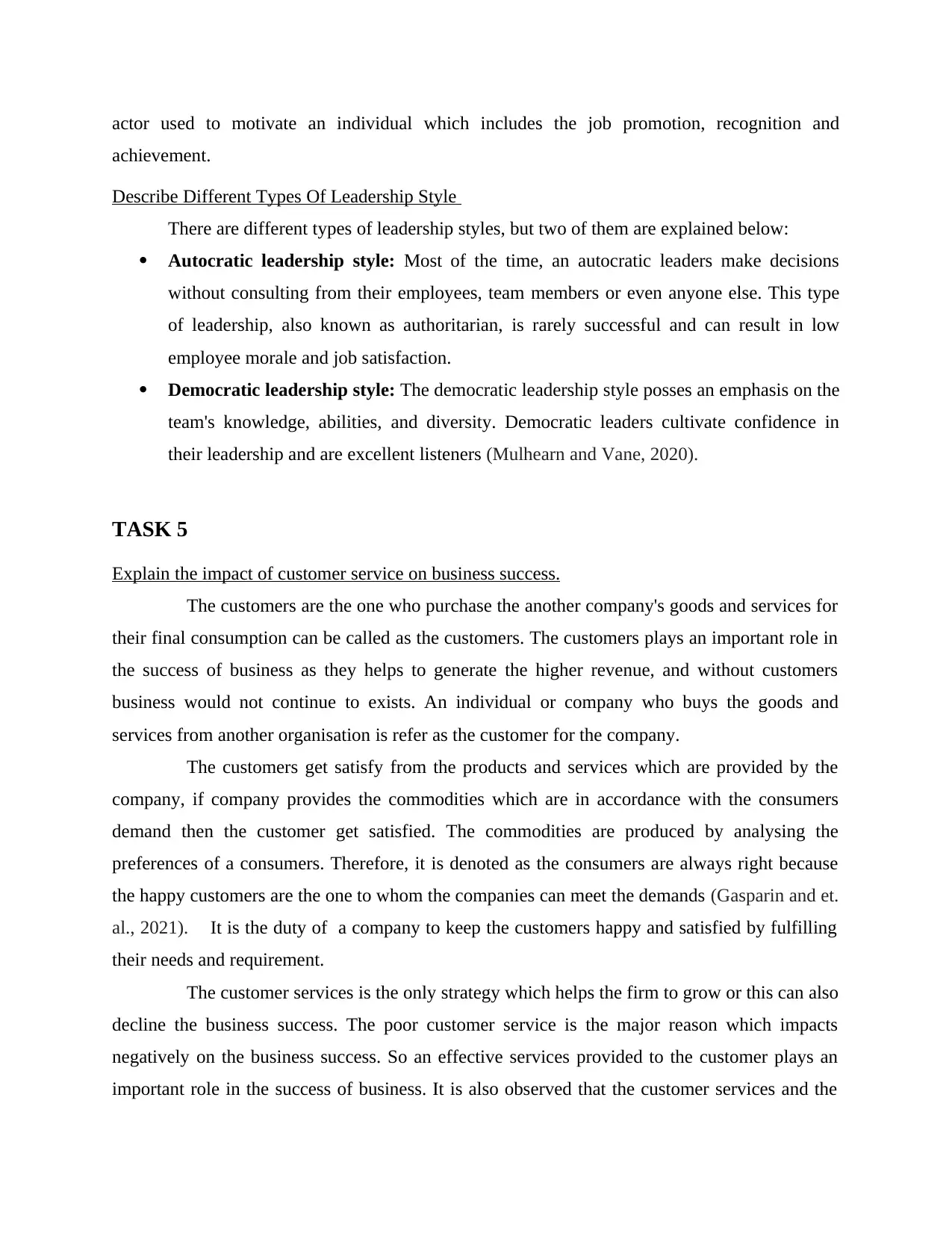
actor used to motivate an individual which includes the job promotion, recognition and
achievement.
Describe Different Types Of Leadership Style
There are different types of leadership styles, but two of them are explained below:
Autocratic leadership style: Most of the time, an autocratic leaders make decisions
without consulting from their employees, team members or even anyone else. This type
of leadership, also known as authoritarian, is rarely successful and can result in low
employee morale and job satisfaction.
Democratic leadership style: The democratic leadership style posses an emphasis on the
team's knowledge, abilities, and diversity. Democratic leaders cultivate confidence in
their leadership and are excellent listeners (Mulhearn and Vane, 2020).
TASK 5
Explain the impact of customer service on business success.
The customers are the one who purchase the another company's goods and services for
their final consumption can be called as the customers. The customers plays an important role in
the success of business as they helps to generate the higher revenue, and without customers
business would not continue to exists. An individual or company who buys the goods and
services from another organisation is refer as the customer for the company.
The customers get satisfy from the products and services which are provided by the
company, if company provides the commodities which are in accordance with the consumers
demand then the customer get satisfied. The commodities are produced by analysing the
preferences of a consumers. Therefore, it is denoted as the consumers are always right because
the happy customers are the one to whom the companies can meet the demands (Gasparin and et.
al., 2021). It is the duty of a company to keep the customers happy and satisfied by fulfilling
their needs and requirement.
The customer services is the only strategy which helps the firm to grow or this can also
decline the business success. The poor customer service is the major reason which impacts
negatively on the business success. So an effective services provided to the customer plays an
important role in the success of business. It is also observed that the customer services and the
achievement.
Describe Different Types Of Leadership Style
There are different types of leadership styles, but two of them are explained below:
Autocratic leadership style: Most of the time, an autocratic leaders make decisions
without consulting from their employees, team members or even anyone else. This type
of leadership, also known as authoritarian, is rarely successful and can result in low
employee morale and job satisfaction.
Democratic leadership style: The democratic leadership style posses an emphasis on the
team's knowledge, abilities, and diversity. Democratic leaders cultivate confidence in
their leadership and are excellent listeners (Mulhearn and Vane, 2020).
TASK 5
Explain the impact of customer service on business success.
The customers are the one who purchase the another company's goods and services for
their final consumption can be called as the customers. The customers plays an important role in
the success of business as they helps to generate the higher revenue, and without customers
business would not continue to exists. An individual or company who buys the goods and
services from another organisation is refer as the customer for the company.
The customers get satisfy from the products and services which are provided by the
company, if company provides the commodities which are in accordance with the consumers
demand then the customer get satisfied. The commodities are produced by analysing the
preferences of a consumers. Therefore, it is denoted as the consumers are always right because
the happy customers are the one to whom the companies can meet the demands (Gasparin and et.
al., 2021). It is the duty of a company to keep the customers happy and satisfied by fulfilling
their needs and requirement.
The customer services is the only strategy which helps the firm to grow or this can also
decline the business success. The poor customer service is the major reason which impacts
negatively on the business success. So an effective services provided to the customer plays an
important role in the success of business. It is also observed that the customer services and the
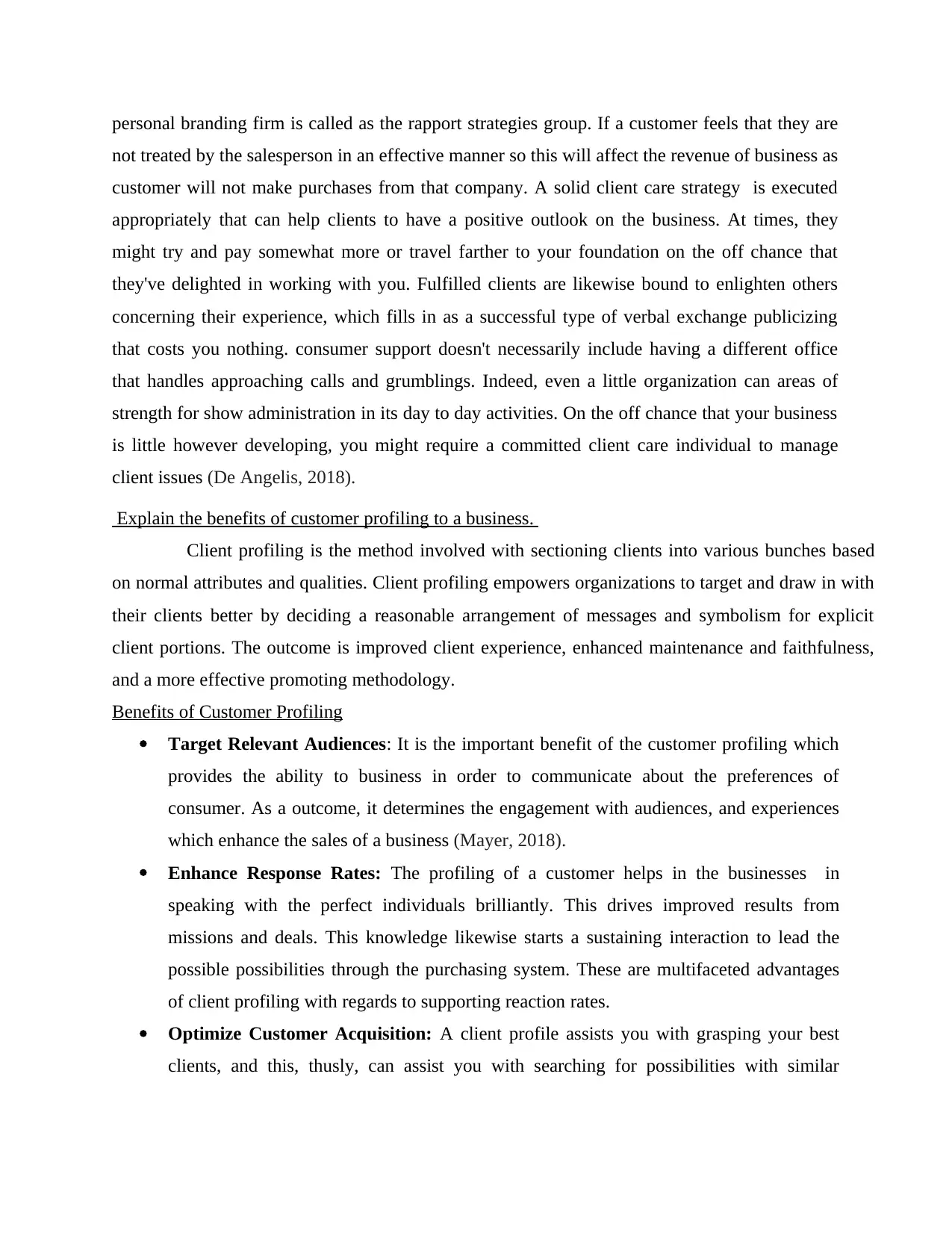
personal branding firm is called as the rapport strategies group. If a customer feels that they are
not treated by the salesperson in an effective manner so this will affect the revenue of business as
customer will not make purchases from that company. A solid client care strategy is executed
appropriately that can help clients to have a positive outlook on the business. At times, they
might try and pay somewhat more or travel farther to your foundation on the off chance that
they've delighted in working with you. Fulfilled clients are likewise bound to enlighten others
concerning their experience, which fills in as a successful type of verbal exchange publicizing
that costs you nothing. consumer support doesn't necessarily include having a different office
that handles approaching calls and grumblings. Indeed, even a little organization can areas of
strength for show administration in its day to day activities. On the off chance that your business
is little however developing, you might require a committed client care individual to manage
client issues (De Angelis, 2018).
Explain the benefits of customer profiling to a business.
Client profiling is the method involved with sectioning clients into various bunches based
on normal attributes and qualities. Client profiling empowers organizations to target and draw in with
their clients better by deciding a reasonable arrangement of messages and symbolism for explicit
client portions. The outcome is improved client experience, enhanced maintenance and faithfulness,
and a more effective promoting methodology.
Benefits of Customer Profiling
Target Relevant Audiences: It is the important benefit of the customer profiling which
provides the ability to business in order to communicate about the preferences of
consumer. As a outcome, it determines the engagement with audiences, and experiences
which enhance the sales of a business (Mayer, 2018).
Enhance Response Rates: The profiling of a customer helps in the businesses in
speaking with the perfect individuals brilliantly. This drives improved results from
missions and deals. This knowledge likewise starts a sustaining interaction to lead the
possible possibilities through the purchasing system. These are multifaceted advantages
of client profiling with regards to supporting reaction rates.
Optimize Customer Acquisition: A client profile assists you with grasping your best
clients, and this, thusly, can assist you with searching for possibilities with similar
not treated by the salesperson in an effective manner so this will affect the revenue of business as
customer will not make purchases from that company. A solid client care strategy is executed
appropriately that can help clients to have a positive outlook on the business. At times, they
might try and pay somewhat more or travel farther to your foundation on the off chance that
they've delighted in working with you. Fulfilled clients are likewise bound to enlighten others
concerning their experience, which fills in as a successful type of verbal exchange publicizing
that costs you nothing. consumer support doesn't necessarily include having a different office
that handles approaching calls and grumblings. Indeed, even a little organization can areas of
strength for show administration in its day to day activities. On the off chance that your business
is little however developing, you might require a committed client care individual to manage
client issues (De Angelis, 2018).
Explain the benefits of customer profiling to a business.
Client profiling is the method involved with sectioning clients into various bunches based
on normal attributes and qualities. Client profiling empowers organizations to target and draw in with
their clients better by deciding a reasonable arrangement of messages and symbolism for explicit
client portions. The outcome is improved client experience, enhanced maintenance and faithfulness,
and a more effective promoting methodology.
Benefits of Customer Profiling
Target Relevant Audiences: It is the important benefit of the customer profiling which
provides the ability to business in order to communicate about the preferences of
consumer. As a outcome, it determines the engagement with audiences, and experiences
which enhance the sales of a business (Mayer, 2018).
Enhance Response Rates: The profiling of a customer helps in the businesses in
speaking with the perfect individuals brilliantly. This drives improved results from
missions and deals. This knowledge likewise starts a sustaining interaction to lead the
possible possibilities through the purchasing system. These are multifaceted advantages
of client profiling with regards to supporting reaction rates.
Optimize Customer Acquisition: A client profile assists you with grasping your best
clients, and this, thusly, can assist you with searching for possibilities with similar
Paraphrase This Document
Need a fresh take? Get an instant paraphrase of this document with our AI Paraphraser
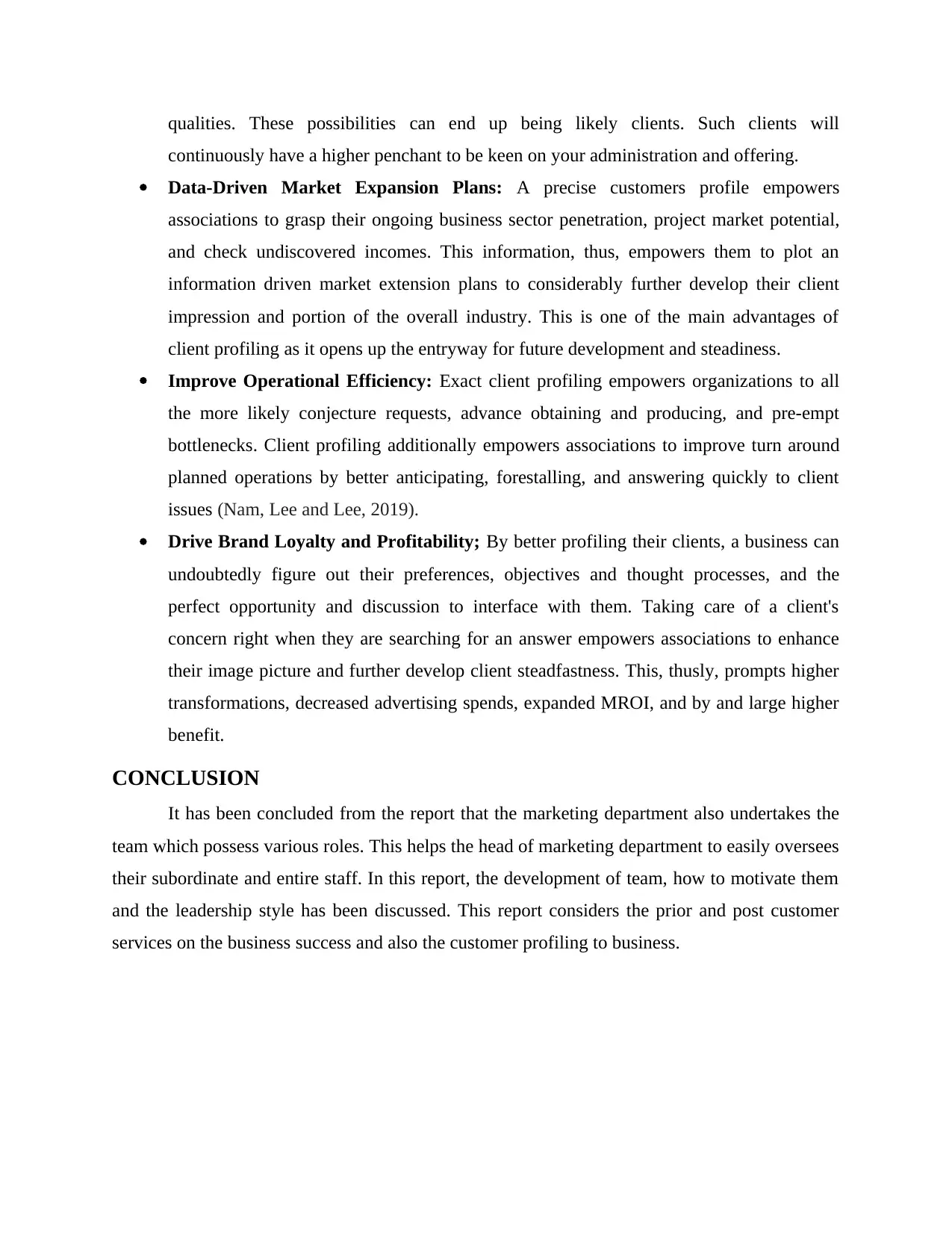
qualities. These possibilities can end up being likely clients. Such clients will
continuously have a higher penchant to be keen on your administration and offering.
Data-Driven Market Expansion Plans: A precise customers profile empowers
associations to grasp their ongoing business sector penetration, project market potential,
and check undiscovered incomes. This information, thus, empowers them to plot an
information driven market extension plans to considerably further develop their client
impression and portion of the overall industry. This is one of the main advantages of
client profiling as it opens up the entryway for future development and steadiness.
Improve Operational Efficiency: Exact client profiling empowers organizations to all
the more likely conjecture requests, advance obtaining and producing, and pre-empt
bottlenecks. Client profiling additionally empowers associations to improve turn around
planned operations by better anticipating, forestalling, and answering quickly to client
issues (Nam, Lee and Lee, 2019).
Drive Brand Loyalty and Profitability; By better profiling their clients, a business can
undoubtedly figure out their preferences, objectives and thought processes, and the
perfect opportunity and discussion to interface with them. Taking care of a client's
concern right when they are searching for an answer empowers associations to enhance
their image picture and further develop client steadfastness. This, thusly, prompts higher
transformations, decreased advertising spends, expanded MROI, and by and large higher
benefit.
CONCLUSION
It has been concluded from the report that the marketing department also undertakes the
team which possess various roles. This helps the head of marketing department to easily oversees
their subordinate and entire staff. In this report, the development of team, how to motivate them
and the leadership style has been discussed. This report considers the prior and post customer
services on the business success and also the customer profiling to business.
continuously have a higher penchant to be keen on your administration and offering.
Data-Driven Market Expansion Plans: A precise customers profile empowers
associations to grasp their ongoing business sector penetration, project market potential,
and check undiscovered incomes. This information, thus, empowers them to plot an
information driven market extension plans to considerably further develop their client
impression and portion of the overall industry. This is one of the main advantages of
client profiling as it opens up the entryway for future development and steadiness.
Improve Operational Efficiency: Exact client profiling empowers organizations to all
the more likely conjecture requests, advance obtaining and producing, and pre-empt
bottlenecks. Client profiling additionally empowers associations to improve turn around
planned operations by better anticipating, forestalling, and answering quickly to client
issues (Nam, Lee and Lee, 2019).
Drive Brand Loyalty and Profitability; By better profiling their clients, a business can
undoubtedly figure out their preferences, objectives and thought processes, and the
perfect opportunity and discussion to interface with them. Taking care of a client's
concern right when they are searching for an answer empowers associations to enhance
their image picture and further develop client steadfastness. This, thusly, prompts higher
transformations, decreased advertising spends, expanded MROI, and by and large higher
benefit.
CONCLUSION
It has been concluded from the report that the marketing department also undertakes the
team which possess various roles. This helps the head of marketing department to easily oversees
their subordinate and entire staff. In this report, the development of team, how to motivate them
and the leadership style has been discussed. This report considers the prior and post customer
services on the business success and also the customer profiling to business.
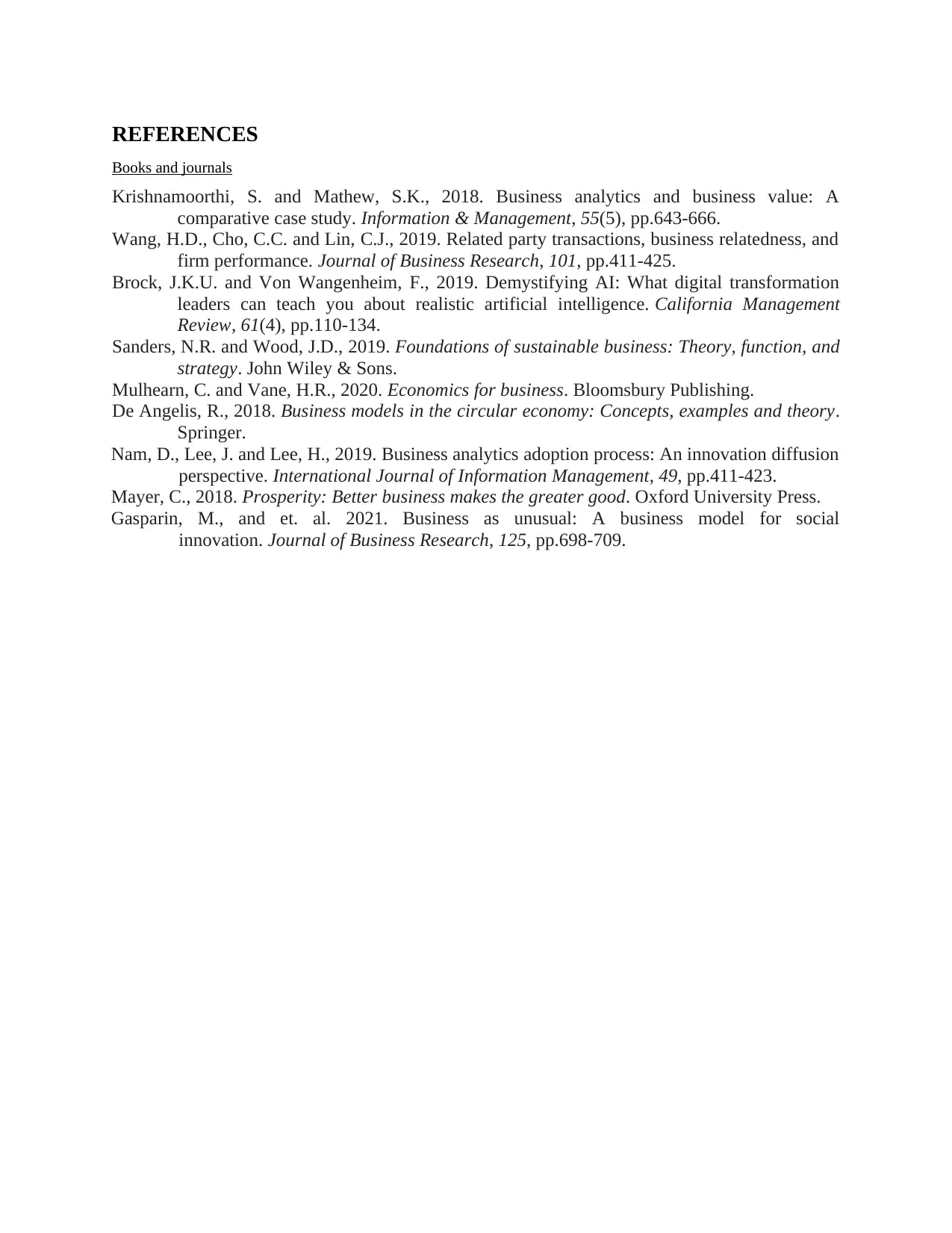
REFERENCES
Books and journals
Krishnamoorthi, S. and Mathew, S.K., 2018. Business analytics and business value: A
comparative case study. Information & Management, 55(5), pp.643-666.
Wang, H.D., Cho, C.C. and Lin, C.J., 2019. Related party transactions, business relatedness, and
firm performance. Journal of Business Research, 101, pp.411-425.
Brock, J.K.U. and Von Wangenheim, F., 2019. Demystifying AI: What digital transformation
leaders can teach you about realistic artificial intelligence. California Management
Review, 61(4), pp.110-134.
Sanders, N.R. and Wood, J.D., 2019. Foundations of sustainable business: Theory, function, and
strategy. John Wiley & Sons.
Mulhearn, C. and Vane, H.R., 2020. Economics for business. Bloomsbury Publishing.
De Angelis, R., 2018. Business models in the circular economy: Concepts, examples and theory.
Springer.
Nam, D., Lee, J. and Lee, H., 2019. Business analytics adoption process: An innovation diffusion
perspective. International Journal of Information Management, 49, pp.411-423.
Mayer, C., 2018. Prosperity: Better business makes the greater good. Oxford University Press.
Gasparin, M., and et. al. 2021. Business as unusual: A business model for social
innovation. Journal of Business Research, 125, pp.698-709.
Books and journals
Krishnamoorthi, S. and Mathew, S.K., 2018. Business analytics and business value: A
comparative case study. Information & Management, 55(5), pp.643-666.
Wang, H.D., Cho, C.C. and Lin, C.J., 2019. Related party transactions, business relatedness, and
firm performance. Journal of Business Research, 101, pp.411-425.
Brock, J.K.U. and Von Wangenheim, F., 2019. Demystifying AI: What digital transformation
leaders can teach you about realistic artificial intelligence. California Management
Review, 61(4), pp.110-134.
Sanders, N.R. and Wood, J.D., 2019. Foundations of sustainable business: Theory, function, and
strategy. John Wiley & Sons.
Mulhearn, C. and Vane, H.R., 2020. Economics for business. Bloomsbury Publishing.
De Angelis, R., 2018. Business models in the circular economy: Concepts, examples and theory.
Springer.
Nam, D., Lee, J. and Lee, H., 2019. Business analytics adoption process: An innovation diffusion
perspective. International Journal of Information Management, 49, pp.411-423.
Mayer, C., 2018. Prosperity: Better business makes the greater good. Oxford University Press.
Gasparin, M., and et. al. 2021. Business as unusual: A business model for social
innovation. Journal of Business Research, 125, pp.698-709.
1 out of 9
Related Documents
Your All-in-One AI-Powered Toolkit for Academic Success.
+13062052269
info@desklib.com
Available 24*7 on WhatsApp / Email
![[object Object]](/_next/static/media/star-bottom.7253800d.svg)
Unlock your academic potential
© 2024 | Zucol Services PVT LTD | All rights reserved.




